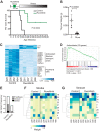Janus Kinase Mutations in Mice Lacking PU.1 and Spi-B Drive B Cell Leukemia through Reactive Oxygen Species-Induced DNA Damage
- PMID: 32631903
- PMCID: PMC7459267
- DOI: 10.1128/MCB.00189-20
Janus Kinase Mutations in Mice Lacking PU.1 and Spi-B Drive B Cell Leukemia through Reactive Oxygen Species-Induced DNA Damage
Abstract
Precursor B cell acute lymphoblastic leukemia (B-ALL) is caused by genetic lesions in developing B cells that function as drivers for the accumulation of additional mutations in an evolutionary selection process. We investigated secondary drivers of leukemogenesis in a mouse model of B-ALL driven by PU.1/Spi-B deletion (Mb1-CreΔPB). Whole-exome-sequencing analysis revealed recurrent mutations in Jak3 (encoding Janus kinase 3), Jak1, and Ikzf3 (encoding Aiolos). Mutations with a high variant-allele frequency (VAF) were dominated by C→T transition mutations that were compatible with activation-induced cytidine deaminase, whereas the majority of mutations, with a low VAF, were dominated by C→A transversions associated with 8-oxoguanine DNA damage caused by reactive oxygen species (ROS). The Janus kinase (JAK) inhibitor ruxolitinib delayed leukemia onset, reduced ROS and ROS-induced gene expression signatures, and altered ROS-induced mutational signatures. These results reveal that JAK mutations can alter the course of leukemia clonal evolution through ROS-induced DNA damage.
Keywords: ETS transcription factors; PU.1; Spi-B; gene regulation; leukemia; reactive oxygen species; transcription factors.
Copyright © 2020 American Society for Microbiology.
Figures







Similar articles
-
Driver mutations in Janus kinases in a mouse model of B-cell leukemia induced by deletion of PU.1 and Spi-B.Blood Adv. 2018 Nov 13;2(21):2798-2810. doi: 10.1182/bloodadvances.2018019950. Blood Adv. 2018. PMID: 30355579 Free PMC article.
-
N-Acetylcysteine Alters Disease Progression and Increases Janus Kinase Mutation Frequency in a Mouse Model of Precursor B-Cell Acute Lymphoblastic Leukemia.J Pharmacol Exp Ther. 2024 Mar 15;389(1):40-50. doi: 10.1124/jpet.123.002000. J Pharmacol Exp Ther. 2024. PMID: 38336380
-
Distinct Acute Lymphoblastic Leukemia (ALL)-associated Janus Kinase 3 (JAK3) Mutants Exhibit Different Cytokine-Receptor Requirements and JAK Inhibitor Specificities.J Biol Chem. 2015 Nov 27;290(48):29022-34. doi: 10.1074/jbc.M115.670224. Epub 2015 Oct 7. J Biol Chem. 2015. PMID: 26446793 Free PMC article.
-
PU.1: a crucial and versatile player in hematopoiesis and leukemia.Int J Biochem Cell Biol. 2008;40(1):22-7. doi: 10.1016/j.biocel.2007.01.026. Epub 2007 Feb 4. Int J Biochem Cell Biol. 2008. PMID: 17374502 Review.
-
JAK3 pathway is constitutively active in B-lineage acute lymphoblastic leukemia.Expert Rev Anticancer Ther. 2011 Jan;11(1):37-48. doi: 10.1586/era.10.203. Epub 2010 Nov 11. Expert Rev Anticancer Ther. 2011. PMID: 21070101 Review.
Cited by
-
Crosstalk Between Autophagy and Oxidative Stress in Hematological Malignancies: Mechanisms, Implications, and Therapeutic Potential.Antioxidants (Basel). 2025 Feb 25;14(3):264. doi: 10.3390/antiox14030264. Antioxidants (Basel). 2025. PMID: 40227235 Free PMC article. Review.
-
Targeting Redox Regulation as a Therapeutic Opportunity against Acute Leukemia: Pro-Oxidant Strategy or Antioxidant Approach?Antioxidants (Basel). 2022 Aug 29;11(9):1696. doi: 10.3390/antiox11091696. Antioxidants (Basel). 2022. PMID: 36139768 Free PMC article. Review.
-
Reactive Oxygen Species and Metabolism in Leukemia: A Dangerous Liaison.Front Immunol. 2022 Jun 9;13:889875. doi: 10.3389/fimmu.2022.889875. eCollection 2022. Front Immunol. 2022. PMID: 35757686 Free PMC article. Review.
-
Reactive Oxygen Species in Acute Lymphoblastic Leukaemia: Reducing Radicals to Refine Responses.Antioxidants (Basel). 2021 Oct 14;10(10):1616. doi: 10.3390/antiox10101616. Antioxidants (Basel). 2021. PMID: 34679751 Free PMC article. Review.
-
In Vitro and In Vivo Modeling of Normal and Leukemic Bone Marrow Niches: Cellular Senescence Contribution to Leukemia Induction and Progression.Int J Mol Sci. 2022 Jul 1;23(13):7350. doi: 10.3390/ijms23137350. Int J Mol Sci. 2022. PMID: 35806354 Free PMC article. Review.
References
-
- Swaminathan S, Klemm L, Park E, Papaemmanuil E, Ford A, Kweon SM, Trageser D, Hasselfeld B, Henke N, Mooster J, Geng H, Schwarz K, Kogan SC, Casellas R, Schatz DG, Lieber MR, Greaves MF, Muschen M. 2015. Mechanisms of clonal evolution in childhood acute lymphoblastic leukemia. Nat Immunol 16:766–774. doi:10.1038/ni.3160. - DOI - PMC - PubMed
Publication types
MeSH terms
Substances
Grants and funding
LinkOut - more resources
Full Text Sources
Molecular Biology Databases
Research Materials
Miscellaneous
